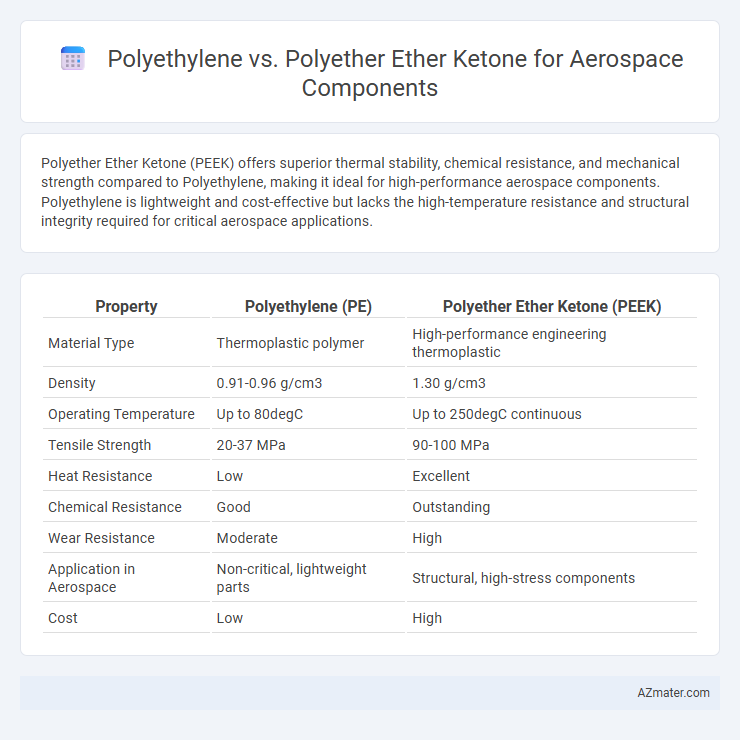Polyether Ether Ketone (PEEK) offers superior thermal stability, chemical resistance, and mechanical strength compared to Polyethylene, making it ideal for high-performance aerospace components. Polyethylene is lightweight and cost-effective but lacks the high-temperature resistance and structural integrity required for critical aerospace applications.
Table of Comparison
| Property | Polyethylene (PE) | Polyether Ether Ketone (PEEK) |
|---|---|---|
| Material Type | Thermoplastic polymer | High-performance engineering thermoplastic |
| Density | 0.91-0.96 g/cm3 | 1.30 g/cm3 |
| Operating Temperature | Up to 80degC | Up to 250degC continuous |
| Tensile Strength | 20-37 MPa | 90-100 MPa |
| Heat Resistance | Low | Excellent |
| Chemical Resistance | Good | Outstanding |
| Wear Resistance | Moderate | High |
| Application in Aerospace | Non-critical, lightweight parts | Structural, high-stress components |
| Cost | Low | High |
Introduction to Aerospace Polymers: Polyethylene vs PEEK
Polyethylene and Polyether Ether Ketone (PEEK) are prominent aerospace polymers with distinct properties influencing their use in aerospace components. Polyethylene offers lightweight, cost-effective solutions with good chemical resistance but limited high-temperature performance, whereas PEEK provides exceptional thermal stability, mechanical strength, and resistance to radiation and chemicals, making it suitable for demanding aerospace environments. The choice between polyethylene and PEEK depends on specific aerospace application requirements such as temperature tolerance, mechanical load, and environmental exposure.
Material Properties Overview: Polyethylene and PEEK
Polyether Ether Ketone (PEEK) exhibits superior thermal stability, mechanical strength, and chemical resistance compared to Polyethylene, making it ideal for aerospace components exposed to extreme environments. Polyethylene offers excellent flexibility and impact resistance but lacks the high-temperature performance and structural rigidity required in advanced aerospace applications. The distinct crystallinity and molecular structure of PEEK provide enhanced durability and dimensional stability essential for critical aerospace parts.
Mechanical Strength and Durability Comparison
Polyether Ether Ketone (PEEK) exhibits superior mechanical strength and durability compared to Polyethylene, making it more suitable for demanding aerospace components exposed to high stress and temperature variations. PEEK's tensile strength ranges from 90 to 100 MPa, surpassing the typical 20 to 40 MPa strength of high-density polyethylene (HDPE), ensuring enhanced resistance to deformation and fatigue. Its exceptional resistance to chemical degradation and long-term thermal stability up to 250degC further guarantee reliable performance in harsh aerospace environments.
Thermal Stability in Aerospace Environments
Polyether Ether Ketone (PEEK) offers superior thermal stability compared to Polyethylene, maintaining structural integrity at temperatures exceeding 250degC, crucial for aerospace components exposed to extreme thermal cycles. Polyethylene's lower melting point, typically around 120degC, limits its application in high-temperature aerospace environments where durability and resistance to thermal degradation are imperative. The exceptional thermal resistance of PEEK along with its mechanical strength and chemical resistance makes it the preferred choice for aerospace parts requiring long-term performance under fluctuating thermal stresses.
Weight Implications for Aircraft and Spacecraft
Polyether Ether Ketone (PEEK) offers significant weight advantages over traditional polyethylene in aerospace components due to its high strength-to-weight ratio and superior thermal stability, enabling lighter structures without compromising durability. The low density of PEEK, approximately 1.3 g/cm3 compared to polyethylene's range of 0.92-0.96 g/cm3, reduces overall aircraft and spacecraft mass, improving fuel efficiency and payload capacity. Weight reduction in aerospace materials directly correlates with enhanced performance metrics such as increased range, reduced emissions, and optimized launch costs.
Chemical Resistance and Corrosion Protection
Polyether Ether Ketone (PEEK) offers superior chemical resistance and corrosion protection compared to Polyethylene (PE), especially in aggressive aerospace environments involving fuels, lubricants, and hydraulic fluids. PEEK's aromatic backbone provides exceptional stability against oxidation and hydrolysis, ensuring long-term component integrity under high-temperature and oxidative conditions common in aerospace applications. Conversely, Polyethylene, while cost-effective and lightweight, tends to degrade faster when exposed to harsh chemicals and elevated temperatures, limiting its use in critical aerospace components requiring robust corrosion resistance.
Manufacturability and Processing Techniques
Polyether Ether Ketone (PEEK) exhibits superior manufacturability for aerospace components due to its high thermal stability and excellent chemical resistance, enabling precision machining and advanced processing methods such as injection molding and CNC machining. Polyethylene (PE), while easier to process through extrusion and thermoforming techniques, lacks the mechanical strength and thermal performance required for demanding aerospace applications, limiting its use primarily to non-structural components. PEEK's compatibility with automated manufacturing processes and additive manufacturing technologies further enhances its suitability for complex aerospace parts requiring stringent quality and durability standards.
Cost Analysis: Polyethylene vs PEEK
Polyethylene offers a significantly lower material cost compared to Polyether Ether Ketone (PEEK), making it a more economical choice for less demanding aerospace components. PEEK, though more expensive, provides superior mechanical properties, chemical resistance, and high-temperature stability essential for critical aerospace applications. The cost-benefit analysis favors polyethylene for non-structural parts, while PEEK justifies its premium price due to performance advantages in high-stress environments.
Typical Aerospace Applications for Each Polymer
Polyether Ether Ketone (PEEK) is extensively used in aerospace applications requiring high thermal stability, chemical resistance, and mechanical strength, such as aircraft structural components, engine parts, and electrical connectors. Polyethylene (PE), especially ultra-high-molecular-weight polyethylene (UHMWPE), is commonly applied in aerospace for lightweight, impact-resistant parts like bearings, seals, and cable insulation. The exceptional durability of PEEK under extreme conditions makes it ideal for high-performance aerospace parts, whereas polyethylene provides cost-effective solutions for wear-resistant and low-friction applications.
Future Trends in Aerospace Material Selection
Polyether ether ketone (PEEK) is increasingly favored over polyethylene in aerospace component manufacturing due to its superior thermal stability, chemical resistance, and mechanical strength under extreme conditions. Future trends indicate a growing emphasis on lightweight, high-performance polymers like PEEK, driven by the aerospace industry's need to reduce fuel consumption and emissions while maintaining structural integrity. Advances in additive manufacturing and nanocomposite enhancements further position PEEK as a critical material in next-generation aerospace applications.

Infographic: Polyethylene vs Polyether Ether Ketone for Aerospace Component
 azmater.com
azmater.com